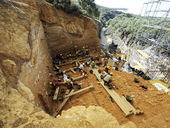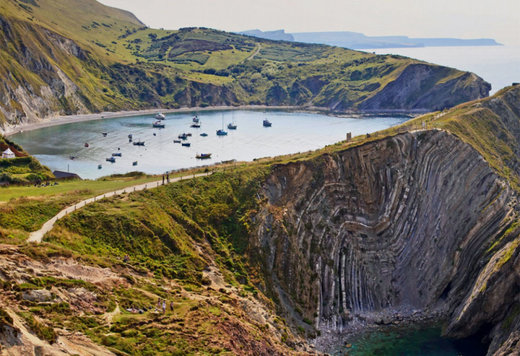
About 150 miles north of Madrid, a jeep pulls up to a clump of trees in the Sierra de Atapuerca, a collection of hills that are rich with caves.
A man with a helmet and a miner's headlamp gets out. He looks more like a mountain guide than a scientist. He's Juan Luis Arsuaga, Spain's best-known paleontologist.
He walks into a large cave, which is marked by a pirate flag. "This is the entrance to the site that has produced the most human fossils in history," Arsuaga says. "What better way to mark it?"
The Atapuerca hills are made of what's called karstic limestone, which means they're riddled with subterranean tunnels and caverns. In the 19th century, a British mining company discovered them when it blasted through a hill to lay down a railway.
At first, only animal bones were found. Then in 1976, a paleontology student found the first human remains. Since then, an abundance of human fossils and stone tools have been found.
Inside the cave, a group of paleontologists prepares to go even deeper underground. One of them is Rolf Quam, a paleoanthropologist from Binghamton University in New York.

Last year, the team uncovered a 1.2 million-year-old jawbone fragment from a species known as Homo antecessor. It's the oldest hominid fossil ever found in western Europe.
Near the railway trench, another site yielded human remains of 28 individuals, dating back at least half a million years. The Spanish paleontologist believes it's a mass grave.
"This was a collective act, something a group did with its dead," Arsuaga says.
The American member of the team says scientists are trying to solve another riddle.
"Why did humans live here continually for a million years? That's one of the big questions we're trying to answer," Quam asks. "What is it about the Sierra that makes it so inviting for human occupation?"
One theory is that the fauna was particularly rich in the Sierra de Atapuerca hills, which lie at the confluence of several geological systems.
Others believe the abundance of caves made it a desirable place to live.
But as the recent find of two more skull fragments demonstrates, there's still a lot to be learned from what lies buried in the hills.



If electrical conditions exceed what we regard as n ormal, then isotopes are created and ions fuse to form new elements, such as iridium. Humans did not live in these caves for that long a period, but how long is most difficult in view of the ineffectiveness of the dating techniques used. Electrical conditions can also alter DNA and RNA. Thus evolution is also sped up.
Still, this site and the Cappodocia caves too, may help us to track all the alterations and even to find a more realistic timeline. The key will be the sheer number of remains.